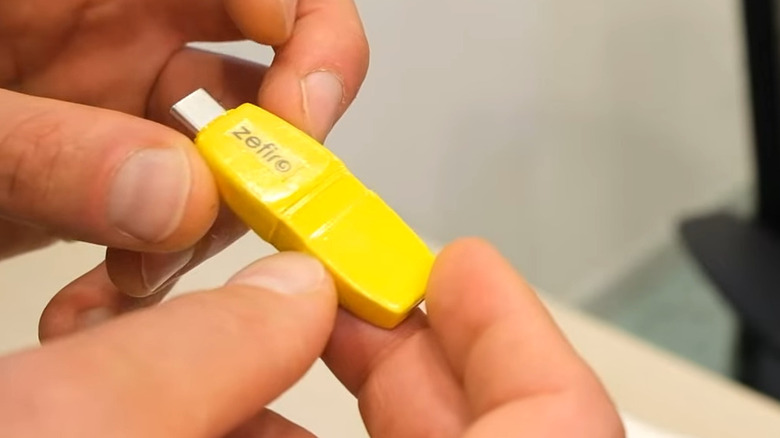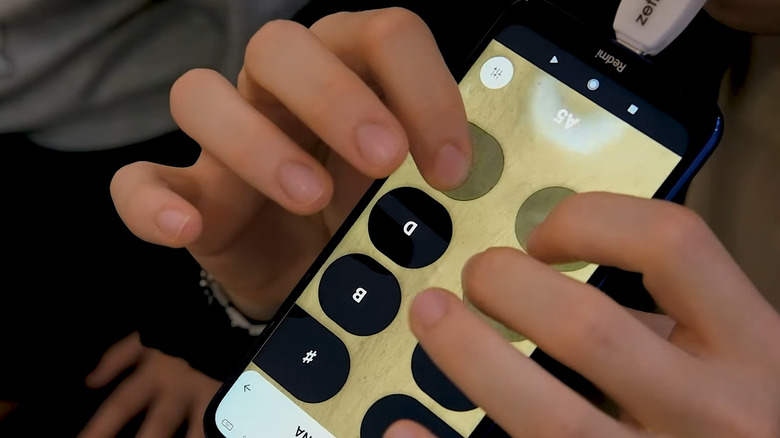This USB Gadget Turns Your Smartphone Into A Musical Instrument
Throughout the years, many different gadgets and apps for making music on your phone have cropped up. Some are focused on transforming your smartphone into a digital sampler, while others give you the option of plugging your instruments directly into an app on your phone to make recording a little more portable. One device builds on this legacy by turning your phone into an instrument you can control with your mouth.
The Zefiro is a "smart reed", named for the lamella used to make sound on reed instruments like clarinets, oboes, and saxophones. It works with an application that you can install on your smartphone or tablet. Using the app, you can control the instrument, customize your settings, record your playing, and even pick a backing track to jam out to. You can also use it to change which virtual instrument you're controlling with the smart reed, with a wide range of options available, including traditional bagpipes and even string instruments.
Artinoise, the company behind the smart gadget, designed the Zefiro as a part of their commitment to making musicality more accessible. Indeed, being able to play around with a huge assortment of virtual instruments using just a phone dongle is far cheaper than having access to a whole orchestra — particularly when the gadget costs roughly $50. This isn't the company's first venture into making digital instruments, either. One of their previous innovations was the Re.Corder, a digital soprano recorder with smartphone integration. This works alongside two of their other products, the Re.Ceiver and the BandHub, both of which are audio interfaces.
How does the Zefiro work?
The mouthpiece works using smart sensors that communicate with an application on your phone. You plug it into your device using the USB-C jack you would normally charge your phone or tablet through. After that, you can connect it directly to the Zefiro smartphone app, where it works as a MIDI input. When you blow into the Zefiro device, it takes the information to the app, which then plays sounds that you can hear.
Smart sensors are key to the device's functionality. These sensors measure the amount of lip and air pressure, which is then shared with the application as MIDI data. MIDI is commonly used in music making, and in the Zefiro's case, it controls the pitch, volume, and harmonics produced in the application. All of these factors are manipulated by the data the smart sensors receive, controlling the sounds made and emulating the way a traditional woodwind or brass instrument would work.
So, the sensors pick up data to control the app. But how do you decide which notes are being played on your virtual instrument? You do this using the Zefiro app, which you control with your fingers and your phone or tablet's touchscreen. Tap the relevant buttons on the screen as you blow into the gadget to play – again, much like playing a physical instrument. It works similarly to how you might close the wind holes on an ocarina or press the finger buttons on a trumpet. This means that your own playing style can even shine through as you use it.
Zefiro vs Zefiro Pro
Artinoise has created two versions of their smart reed: a standard edition and a Pro version. On a cosmetic level, there's not much to differentiate the two, besides a pro label around halfway down the reed. But a microelectromechanical system (MEMS) accelerometer is tucked away inside the pro version to help track your movements and play more accurately. In a way, this makes it more like playing another physical instrument, as it makes it possible to play the Zefiro more expressively.
The built-in MEMS accelerometer measures motion by detecting acceleration across different axes. This means that when you move the Zefiro Pro, the device will communicate that to the software you're using it with, such as the Zefiro app or a Digital Audio Workstation (DAW) like Ableton. This motion then controls exactly how the virtual instrument you're playing sounds, giving your performances more depth and variety by allowing you to nuance your playing style.
Zefiro Pro's enhanced motion tracking is mostly designed for use on its own or with other MIDI instruments for music creation and performance. So, if you're planning to pick up a Zefiro to use with a DAW in your home studio, then you might find the Pro to be the best fit for you. If you're more interested in grooving to the flute with your phone purely for fun instead, then the regular Zefiro will probably suit you just fine. The only other main difference between the two is the price, with the regular Zefiro costing around $50 and the Pro being about $80.


